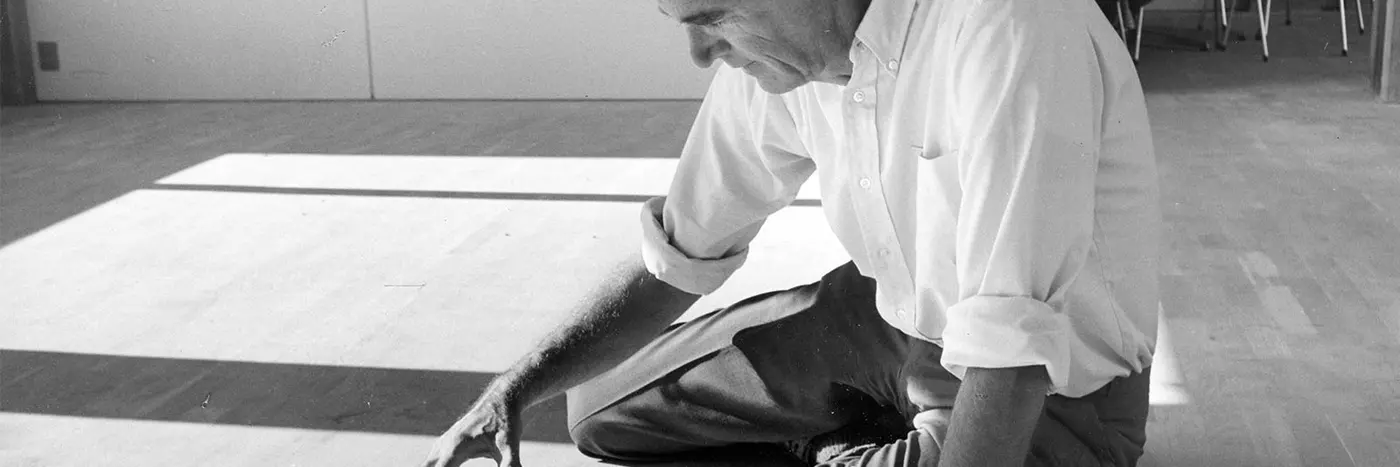How Mexico, Iran and China shaped Utzon’s Opera House
The Horisont exhibition dives into architect Jørn Utzon’s travel diaries
In April 2018, the Utzon Center presented Horisont: an evocative exhibition in celebration of Jørn Utzon AC and the poetic, humane layers of his life’s work coloured by his immersive travel studies of foreign landscapes, people and cultures.
Using a mix of new exhibition material, sensor-driven technologies and drawings, models, photographs and film recordings from Jørn Utzon’s archive collection, the exhibition highlights the mindset of an extraordinary architect and eight of his most important projects: the Hellebæk House (1952), Langelinie Pavilion (1953), the Roman Houses (1954-57), Sydney Opera House (1956-66), Silkeborg Art Museum (1962), Bagsværd Church (1967-76), Kuwait National Assembly Building (1969-82) and Can Lis (1971-73). Every project is exhibited on black-stained, platform-like podiums in a dark room only lit by spotlights and large film projections that wake up as the guest moves through the exhibition.
The exhibition design does not include any walls, but is, in principle, one big free-flowing space, only partitioned by a three-metre tall ribbon of semi-transparent textiles that double as the canvas for projections. In this way, we intend to create an aesthetically beautiful experience with Utzon’s architectural universe that integrates new technologies, tactile materials, immersive film installations and original archive material that together retell the story about how his life’s work evolved and was revitalised alongside his travels in diverse regions of the world.
The 200-600 metre squared exhibition will open for the first time in Utzon Center, Aalborg, followed by a relaunch at the Danish Architecture Centre, Copenhagen, and at Sydney Opera House in coincidence with the 45th anniversary of Jørn Utzon’s Opera House.
Line Nørskov Eriksen, Exhibition Curator‘Horisont’ refers to the importance of widening your horizons and the value of travel for an architect’s creative and critical formation.
The narrative behind the exhibition
Few architects would disagree that Jørn Utzon, Pritzker Prize laureate and architect of the Sydney Opera House, was gifted with an extraordinary creative mind and one of the most important architects of the past century. The range of his life’s work is vast – from the monumentality of his Opera House in Sydney to the monastic and humble nature of Can Lis on Mallorca – but what is fundamentally important is the deeply humanist and poetic ideas running through all of his work like a red thread. His attitude towards architecture is as relevant today as when he was alive, and we, at the Utzon Center, consider this message far too important to be left with architects alone, which is why we have chosen to curate the anniversary exhibition around not just the man but the experiences, people and places – the travel studies – that brought it into being.
Raised in response to the inhumanities of the Two Great Wars, a tradition in architecture emerged seeking to recast modern architecture with stronger ties in more instinctive, authentic modes of expression and the constraints of nature. An impulse to travel emerged; an impulse to experience and learn from places unaffected by the technological progress which had whitewashed western civilisation. The intention was not nostalgic: it was not about reviving the olden days, but recasting anew an approach to modern architecture founded in basic principles of place-making and the unchanging condition of man. Utzon is one of the significant exponents of this movement, who, throughout his life allowed his work – his ideas and his vision – to evolve alongside his encounters with places, people and cultures in distinct and diverse regions of the world. Using his archive – his film recordings and photographs – together with new productions, Horisont explores this fascinating and highly relevant aspect of his work as a point of departure in experiencing his architectural universe.
Jørn Utzon ACYou feel firm ground beneath you, as when standing on a large rock... after weeks of rain, clouds, and darkness, [you] suddenly emerge into the sunlight again.
Following the chronology of his travels, the exhibition begins in Scandinavia – with Utzon’s childhood, his schooling and his creative exile in Stockholm in 1942 installing the curiosity for foreign building cultures and inspiration in nature. Hereafter, we travel in his footsteps to Morocco, Native America, Mexico, China, Japan, India, Nepal, Iran, Hawaii, and the Mediterranean: we meet the people, the landscapes, the ancient architecture and, most importantly, we see how his life’s work evolved at alongside these encounters to get closer to the poetic, humane nucleus that underpin his oeuvre.
The title Horisont refers to the importance of widening horizons and the value travel for an architect’s creative and critical formation. At the same time, the title reflects the ideas Utzon was distilling along the way. Specifically, we see in his work a growing interest for creating architecture resembling clouds hovering above undulated hills, fields, platforms, terraces and plateaus with the endless horizon suspended in between. Mostly, we see it in his public buildings: the Sydney Opera House, Kuwait National Assembly Building, Bagsværd Church, et cetera, but we also see it in the humble, monastic nature of Can Lis, which creates an almost existential feeling of being on the ground under the sky. In this way, Utzon’s worked evolved into something much more than buildings. While he was technically capable (and much more so than most), the basis of his work is founded on a desire to lead people’s lives down a much more authentic, beautiful path.
